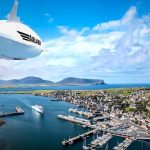

Hybrid aircraft could ‘revolutionise life in the highlands and islands’

A study has highlighted the role that hybrid aircraft could play in the future of transport within the highlands and islands.
Hybrid Air Vehicles (HAV), which has announced the findings, says the Airlander 10 could deliver cost-effective, low-emission passenger transport and freight to communities across the region.
It could help to decarbonise regional travel, add freight capacity into the network, and also provide further economic growth through tourism, according to the new study.
The report concludes that integrating the Airlander into existing inter-island transport services could “greatly improve” regional connectivity, offering a “significant expansion” of current services.
As part of this study, seven on-site surveys were carried out by engineers across HIAL and Orkney Islands Council’s airports, taking into consideration historic weather conditions at each site, as well as runway, boarding and landing infrastructure to assess the compatibility of these existing locations with the operational needs of Airlander.
The locations included Kirkwall, Papa Westray, Stornoway, Barra, Inverness, Sumburgh and Scapa Bay.
Tom Grundy, CEO of HAV, said: “Airlander has the potential to revolutionise life in the highlands and islands, by offering cost-effective and sustainable mobility that fosters improved passenger, freight and logistics connectivity for previously isolated communities, and boost employment, commerce and tourism.
“We are thrilled with the results of the study, which confirm the important role Airlander can play, and our partnership with the wider consortium. We look forward to taking further steps toward offering ultra-low emission Airlander services.”
The study was supported by AECOM, Highlands and Islands Airports Limited (HIAL), Highlands and Islands Transport Partnership (HITRANS), Highlands and Islands Enterprise (HIE), Orkney Islands Council (OIC) and Loganair.